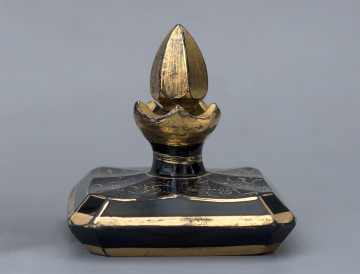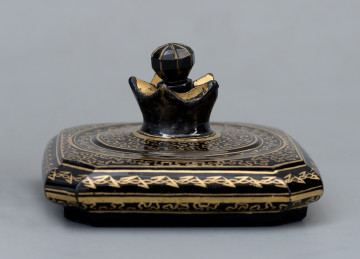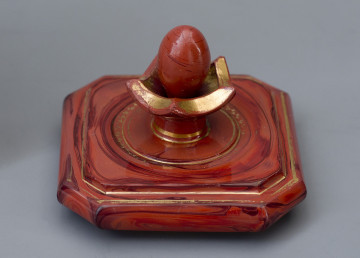
Vial with a cap
Museum of King Jan III's Palace at Wilanów
Part of the collection: Artistic glass
A small, flat vial with a cap, made of hyalith, a type of glass popular in the 19th century. This deeply black material was invented by Georg Franz August Longueval, count of Buquoy (1781–1851). He was a mathematician, a physicist, a chemist, a philosopher as well as an owner of several glass factories. His broad interests and experiments led him to discover a new recipe for non-transparent, black molten glass. Its production started in 1817. Owing to the unique hue, products made of hyalith, such as cups, vials, vases, tea containers or candle-holders, quickly became fashionable and widely in-demand. Their surface was usually decorated with gilding which increased the value of the items and looked very impressive against the black. This type of decoration made the vessels resemble Far Eastern lacquer: they often showed motifs related to art of this region, such as herons, cranes, palm trees, Chinese pavilions and figures of Chinese people performing various activities. However, this vial from the Wilanów collection is decorated with a purely ornamental pattern of winding twigs with fronds. They were drawn with a quill and a steel pen (not a brush) which allowed to obtain a very thin decorative line.
The Wilanów collection also includes two similar vessels (Wil.5706/1 and 5606/2).
Author / creator
Dimensions
entire object: height: 8,0 cm, width: 8,0 cm
Technique
gilding,manual forming
Owner
Museum of King Jan III's Palace at Wilanów
Identification number
Location / status

Museum of King Jan III's Palace at Wilanów

Museum of King Jan III's Palace at Wilanów

Museum of King Jan III's Palace at Wilanów
DISCOVER this TOPIC
National Museum in Lublin
DISCOVER this PATH
Educational path